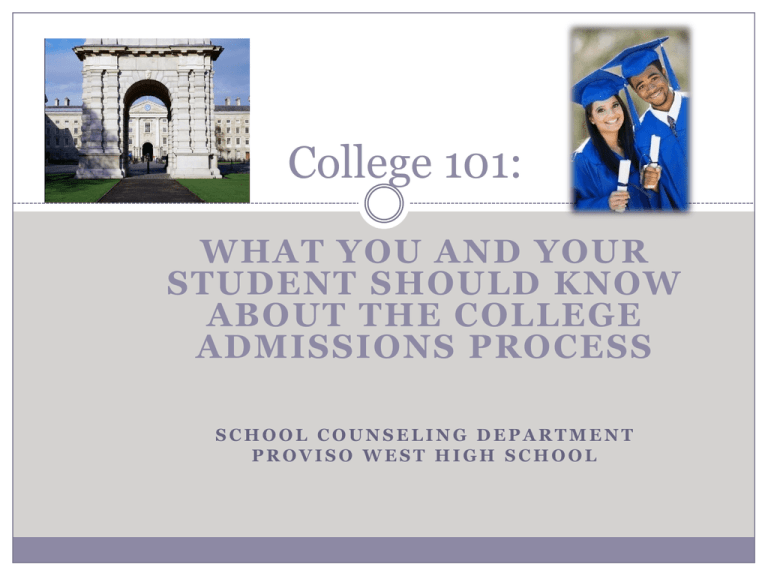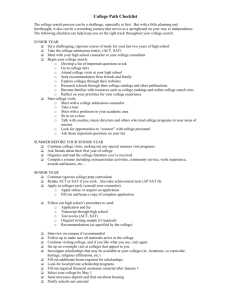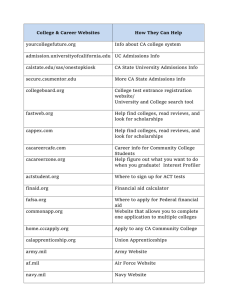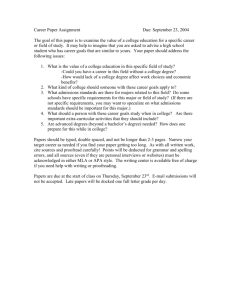Planning for College
advertisement

College 101: WHAT YOU AND YOUR STUDENT SHOULD KNOW ABOUT THE COLLEGE ADMISSIONS PROCESS SCHOOL COUNSELING DEPARTMENT PROVISO WEST HIGH SCHOOL Simplify the College Planning Process College opportunities exist for everyone. These four steps can help simplify the planning process: 1. 2. 3. 4. Understand admissions factors Learn about the SAT and ACT Explore college options Develop a financial plan Understand Admissions Factors What Colleges are Looking At: The first part of planning for college is understanding what factors colleges consider when looking at a student profile. •Primary Factors •Quality/Rigor of Academic Courses •Academic Performance/Grades •Test Scores (SAT & ACT) •Additional Factors •Extracurricular Activities •Essay(s) •Letters of Recommendation •Demonstrated Interest Understanding Admissions Factors Grades & Course Work Your high school academic record is one of the most important factors in college admissions. Colleges will look at a few aspects: Course selection: Challenge yourself with a rigorous course load and high-level classes, including AP or honors courses. Grades: Every year counts, starting with freshman year GPA trends: Keep improving through every grade. Class rank (if offered by your school). Understanding Admissions Factors Other Considerations Positive recommendations from educators and mentors Personal statement and essay(s) demonstrating writing ability and self-expression A “demonstrated interest” that shows your enthusiasm for the colleges to which you’re applying Extracurricular activities, including participation in sports, performing/visual arts, volunteering, etc. Community involvement, part-time work or internship Interview (if applicable) Understanding Admissions Factors Learn about SAT & ACT Test Preparation Getting Ready for the SAT & ACT Select challenging high school courses Read widely and write extensively, both in and out of school Take the PLAN your sophomore year Take the PSAT/NMSQT soph./junior year Become familiar with SAT & ACT question types, format and directions Take advantage of free College Board and ACT resources/High School Test Prep Free/Reduced Lunch-option to retest 2xs for free. Learn about SAT and ACT Preparation Explore College Options Now that you know what colleges are looking for, it’s time to put them to the test. Which college is a good fit?? Explore College Options What to consider: Size and diversity of student body Location (distance, urban/rural) Academic programs Campus Life—athletics, activities, housing Graduation and retention rates Financial aid/scholarship opportunities Above all, think about where your child will be happy and successful in their college life. Explore College Options Factors to consider: Kinds of Colleges Selectivity Public -Open -Traditional -Selective -Highly Selective Private Historically Black Colleges/Universities Size Small Medium Large Application Options -Early Action -Early Decision -Regular Decision -Rolling Admissions Explore College Options Visit Campuses Get to know a school from the inside: Take a campus tour. Speak with an admissions counselor. Ask about academic and career services. Ask about financial aid opportunities. Inquire about support services (counseling, health clinic, etc.). Sit in on a class of interest. Learn about security measures/crime rate. Talk to students and faculty. Ask questions!! Explore College Options Get Organized and Apply Narrow and categorize your choices: “More than likely” schools (1 or 2) “Good match” schools (2 to 4) “Reach” schools (1 to 2) Review scholarship and financial aid requirements Revise application essays and share drafts with a trusted teacher/counselor, adviser or family member. Ask for recommendations and set firm dates for their completion Request transcripts and schedule interviews, if needed. Apply for fee waivers, if applicable. Explore College Options Develop a Financial Plan Add It Up Determine all college costs – not just tuition. Research the percentage of need-based aid met at prospective schools. In-state compared to out-of-state tuition. Estimate your family’s expected contribution – an EFC calculator is available at fafsa.ed.gov. Search free scholarships at collegeboard.com, fastweb.com, scholarships.com, and whatsnextillinois.org. The early bird catches the worm!! ***Remember to explore every opportunity (NJROTC, community organizations, employer, minority scholarships, etc.). Develop a Financial Plan Apply and Compare Know your options: grants, loans, work-study, etc. Fill out the free FAFSA application as early as possible (Jan. 1st), and meet all individual school deadlines. Compare financial aid awards and determine how they fit with other contributions: Family Savings Scholarships Develop a Financial Plan Making a Decision Try to visit colleges where you’ve been accepted. Compare financial aid packages; inform fin. aid offices of any changes that may occur. Send your deposit; read contracts & academic catalogs carefully. Maintain good grades/clean discipline record; colleges can rescind admissions due to poor grades and/or suspensions/arrests. Congratulations, you’re off to college! Now the REAL work begins!! College Planning Recap Remember: College opportunities exist for everyone! Simplify the planning process: Understand admissions factors Learn about the SAT Explore college options Develop a financial plan Alternative Options Community College Trade/Vocational School Military Gap Year Employment Don’t Ask…Don’t Tell… Face book/Professional Student Emails Alternative Admissions Programs (Pros/Cons) Academic Probation (below 2.0 gpa at most schools) Credit Card Debt For Profit Schools Average annual tuition increase College Planning Web Sites whatsnextillinois.org collegeboard.com fastweb.com fafsa.ed.gov scholarships.com actstudent.org and march2success.com (test prep) ncaa.org (potential athletes) careercrusing.com (username triton2000/password rivergrove) (career/college exploration)




